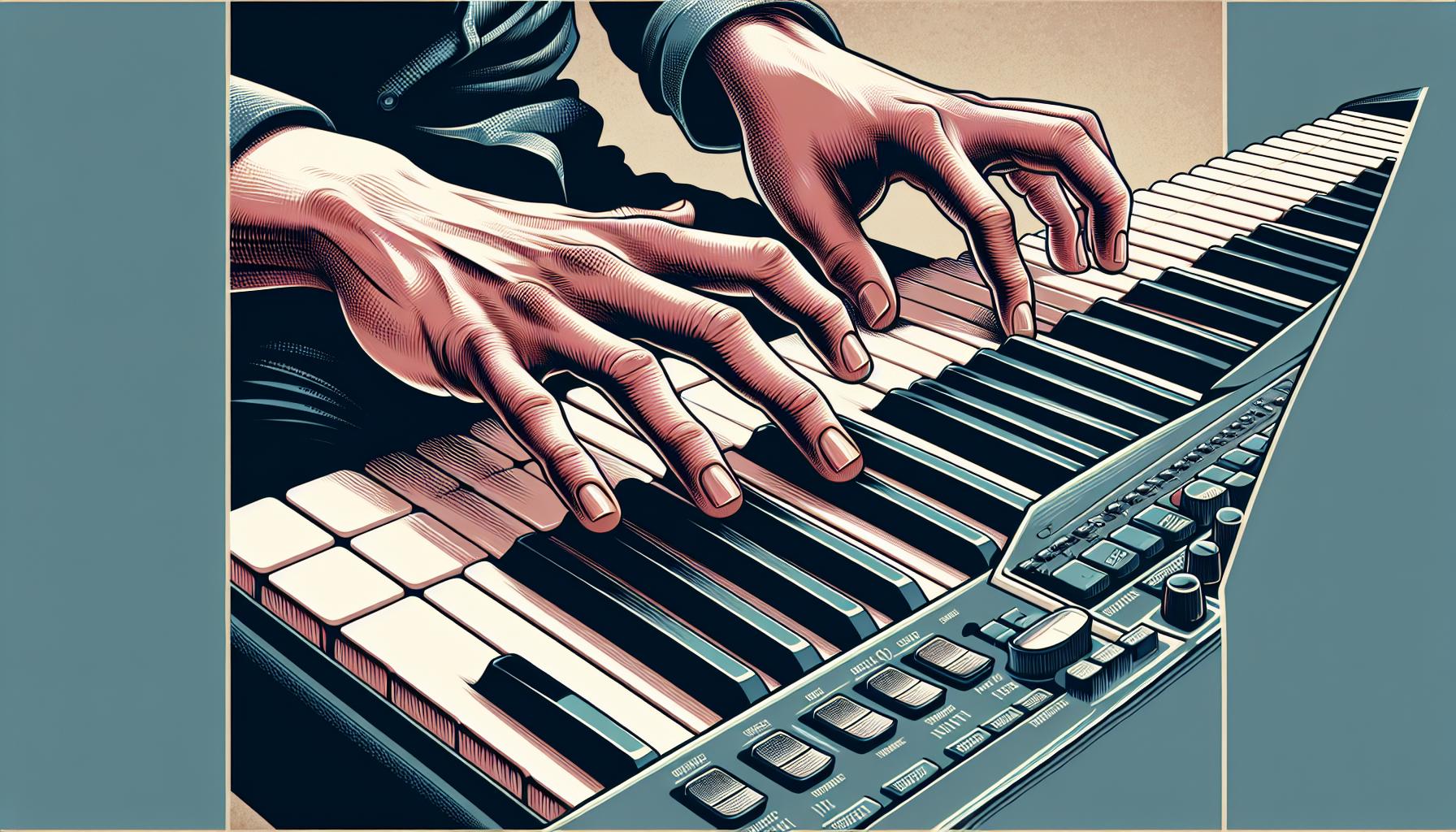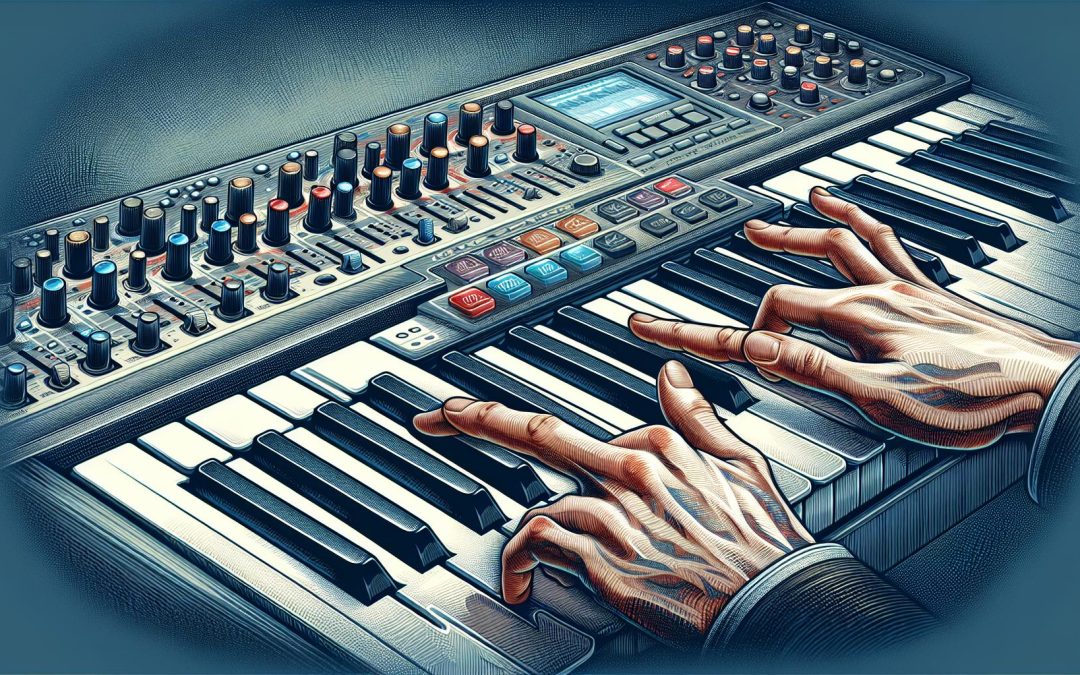Power chords have long been the secret sauce in the recipe of rock and punk music, but who says they're exclusive to the guitar? Keyboard players, rejoice! You're about to unlock a whole new level of cool in your playing. With just a bit of know-how, you can bring that gritty, punchy sound right to your fingertips, no guitar needed.
Whether you're aiming to beef up your band's sound or just add some edge to your solo performances, power chords on the keyboard are your ticket. They're surprisingly simple to master, and once you do, there's no limit to the rock anthems you can crank out. Let's dive in and discover how to make your keyboard roar with the power of chords.
Understanding Power Chords
Power chords are often seen as the backbone of rock and punk music, creating a sound that’s both gritty and compelling. While typically associated with guitars, keyboard players have the ability to harness the raw energy of power chords to add an electrifying element to their performances.
In essence, a power chord consists of the root note and the fifth interval. These chords are commonly notated as a root note followed by the number 5, such as C5 or G5. The simplicity of this structure is what makes power chords especially appealing for musicians looking to add punch without the complexity of full chord shapes.
For keyboard players, executing power chords involves selecting the appropriate root and fifth notes across the keyboard. The technique is straightforward but requires precision to ensure the intended sonic impact. They find this approach enables them to replicate the kind of robust, anthem-like quality that’s often associated with electric guitar riffs.
Key Benefits of Using Power Chords on Keyboard
Incorporating power chords into keyboard playing offers numerous advantages:
- Simplicity: The basic two-note structure makes power chords easy to learn and incorporate into music.
- Versatility: Suitable for various music genres, from rock to punk, and even pop, allowing keyboard players to explore different styles.
- Fullness in Sound: Despite their simplicity, power chords add a fullness and depth to the music, enriching the overall texture.
- Foundation for Creativity: They serve as a stepping stone for more complex compositions, encouraging musicians to experiment with their sound.
Positioning and Technique
Proper finger placement and technique are crucial for playing power chords effectively on the keyboard. Players usually use their thumb for the root note and their middle or ring finger for the fifth, depending on what’s comfortable and the span of their hand. It’s essential for keyboardists to practice moving between chords fluidly to maintain the rhythm of the piece they're playing.
To fully explore the potential of power chords, experimentation with different octave ranges can have a substantial impact on the sound produced. Playing the same chord in a lower octave can provide a heavier, more resonant base, while moving to a higher octave offers a lighter, more ethereal sound.
Setting Up Your Keyboard

Before diving into the exhilarating world of power chords on the keyboard, ensuring your instrument is properly set up is crucial for the best possible sound. This includes adjusting the keyboard settings, tuning, and selecting the right sounds or patches that complement the raw energy of power chords.
Adjusting Keyboard Settings
First, it's important to adjust the keyboard's settings to suit playing power chords. To capture the essence of power chords, which are known for their full and rich sound, selecting a setting that enhances the lower frequencies while maintaining clarity in the higher registers can make a significant difference. Experiment with different equalization (EQ) settings or select a preset that mimics a guitar amplifier. This can add the necessary grit and body to the keyboard's sound, making the power chords punch through any mix.
Choosing the Right Sounds
Selecting the right sounds or patches is another vital step in setting up the keyboard for power chords. While traditional piano or electric piano sounds can work, exploring sounds that have a more pronounced attack and sustain can elevate the performance. Look for synth patches or organ sounds, as these can provide the necessary sustain and depth. Patches that incorporate a slight distortion or overdrive effect can also mimic the aggressiveness of a distorted electric guitar, bringing the keyboard closer to the sound of rock and punk genres.
Tuning and Octave Selection
Tuning is generally not an issue with digital keyboards, but ensuring your instrument is in standard concert pitch (A440 Hz) is important, especially if you're playing with other musicians. When it comes to octave selection, playing power chords in the lower to middle octaves of the keyboard can add fullness to the sound. Experimenting with different octave ranges can help you find the sweet spot where the power chords sound best. Consider blending sounds from different octaves to create a fuller, more layered effect.
Keyboard Action and Feel
Finally, the action and feel of the keyboard can influence how effectively you play power chords. Weighted keys can offer a more expressive range by varying the attack, while semi-weighted or synth-action keys might allow for quicker transitions between chords. While personal preference plays a significant role here, it's worth experimenting with different types of keyboards to see which best suits your playing style.
Playing Power Chords in Different Keys

Mastering power chords on a keyboard not only involves getting comfortable with their structure but also knowing how to transmute their raw energy across various musical keys. Transitioning power chords between keys unlocks a vast landscape of musical expression, vital for both composition and performance.
To start, let’s clarify what power chords are in the context of a keyboard. A power chord typically consists of the root note and the fifth. Sometimes, players add the octave of the root to thicken the sound. Unlike standard chords that outline a song's harmonic structure with thirds, sevenths, and beyond, power chords deliver a more neutral and robust sound, perfect for rock, pop, and electronic music genres.
When moving power chords to different keys, understanding the circle of fifths can be incredibly helpful. The circle of fifths is a visual representation of all musical keys showing their relation based on the fifth interval. By familiarizing themselves with this circle, players can easily modulate power chords between keys, enhancing their musicality and versatility.
Here are a few strategies for playing power chords in various keys:
- Start Simple: Begin with power chords in the key of C Major, which requires no sharps or flats. This simplicity makes it easier to grasp the concept before tackling more complex keys.
- Use Patterns: Recognize that the spacing between the root note and the fifth is consistent regardless of the key. This pattern recognition aids in swift adaptation across the keyboard.
- Practice with Backing Tracks: Playing along with tracks in different keys helps solidify understanding and execution of power chords in diverse musical settings.
Additionally, it's beneficial to become comfortable with transposition — the process of changing a piece of music from one key to another. Many modern keyboards offer built-in transposition functions, allowing players to play in a comfortable key while the keyboard automatically shifts the music to the desired key. While this tool is handy, developing the skill to manually transpose ensures a deeper connection with the music and improves overall keyboard mastery.
- Select a simple song or chord progression.
- Play the progression using power chords in its original key.
- Utilize the circle of fifths to transpose the progression into at least three other keys.
- Practice each transposition with and without the use of the keyboard's transposition function.
Adding Variations and Style

Once keyboard players have a solid grasp on the basic structure of power chords and key transitions, it's time to inject some personality and variety into their play. This can be done by mastering a few techniques that add texture and depth to the otherwise straightforward power chords.
Experimenting with Voicings
One of the first ways to add variation is by experimenting with different voicings. Voicings refer to the way notes of a chord are spread out or ordered. Even though power chords are primarily composed of the root note and the fifth, there's room for creativity in the way these are played:
- Octave Stretching: Playing the root note in one octave and the fifth in another can create a fuller sound.
- Adding an Octave Above: Including another root note an octave above the fifth gives the chord more presence and can often make it punchier.
Rhythmic Variations
Rhythm plays a crucial role in how power chords are perceived. Altering the rhythm can turn a basic progression into something much more interesting:
- Palm Muting: Briefly muting the chords with the palm creates a staccato effect that adds a percussive element to the play.
- Syncopation: Emphasizing off-beats can give power chords a groovy or funky feel, making them less monotonous and more dynamic.
Applying Effects
The digital nature of keyboards allows for the use of built-in effects to enhance the sound of power chords:
- Distortion: Adding a mild distortion effect can emulate the gritty sound often associated with power chords on electric guitars.
- Reverb and Delay: These effects can give chords a sense of space and depth, making them feel more atmospheric.
Combining Techniques
The true artistry comes when players start combining these various techniques. Using different voicings, injecting rhythmic variations, and applying effects strategically can transform simple progressions into engaging musical passages. It's also beneficial to listen to recordings of songs that are known for their effective use of power chords and try to replicate the tone and style.
- Equalization (EQ): Adjusting the EQ settings can highlight the punchiness of the power chords or make them blend better with other instruments.
- Layering: Some advanced keyboards allow players to layer different sounds, which can
Practice Tips for Mastery

To truly master playing power chords on the keyboard, dedicated practice combined with smart strategies is essential. Consistency is key. Setting a regular practice schedule helps in building muscle memory and in deeply understanding the nuances of power chord progression.
Start Slow
Initiate your practice at a slow tempo. This allows you to focus on the accuracy of finger placements and the quality of sound each chord produces. As you become more comfortable, gradually increase the tempo. Remember, speed should never compromise accuracy. Use a metronome to keep track of your tempo and ensure that your timing remains precise.
Break It Down
Complex passages can be overwhelming. Breaking them down into smaller, manageable segments can make practice more effective. Focus on mastering each segment before moving onto the next. This not only helps in learning difficult sections more efficiently but also builds a sense of progress and accomplishment.
Use a Variety of Sounds
Experiment with different sounds and effects on your keyboard. Trying power chords with various instrument sounds or effects like distortion or reverb can inspire creativity and make practice sessions more enjoyable. This not only adds color to your playing but also helps in understanding which sounds work best for different types of music.
Record and Review
Recording your practice sessions provides valuable insights into your playing. Listening back can help you identify areas that need improvement and track your progress over time. It’s often easier to hear discrepancies in timing, dynamics, or tone in a recording than in the moment of playing.
Play Along with Music
Playing along with your favorite songs or backing tracks can make practice feel more engaging. This approach helps in developing timing and rhythm in a musical context. Additionally, it's a fun way to apply what you've learned and see how power chords fit into actual music.
Challenge Yourself Regularly
Set small, achievable goals to keep pushing your boundaries. Whether it's mastering a new song, incorporating a new technique, or increasing your playing speed, having clear objectives can motivate you to practice diligently. Celebrate your achievements, no matter how small, to stay motivated.
Seek Feedback
Getting feedback from more experienced keyboard players can provide valuable insights into your playing. Whether it’s in person or through online forums and communities, constructive criticism can help you identify areas for improvement and provide encouragement.
Conclusion
Mastering power chords on the keyboard is a journey that's both challenging and rewarding. By sticking to a consistent practice routine and embracing the strategies outlined, players will find themselves making significant progress. It's all about patience, persistence, and passion. Remember to enjoy the process, celebrate the small victories, and keep pushing the boundaries of creativity. With time and effort, the power of music will truly come alive under your fingertips.
Harlan Kilstein began playing piano during covid with no piano background at all. He taught himself how to play learning what to do and what not to do.
Today he's an advanced intermediate player and can help you grow in your skills because he learned all this on his own.








